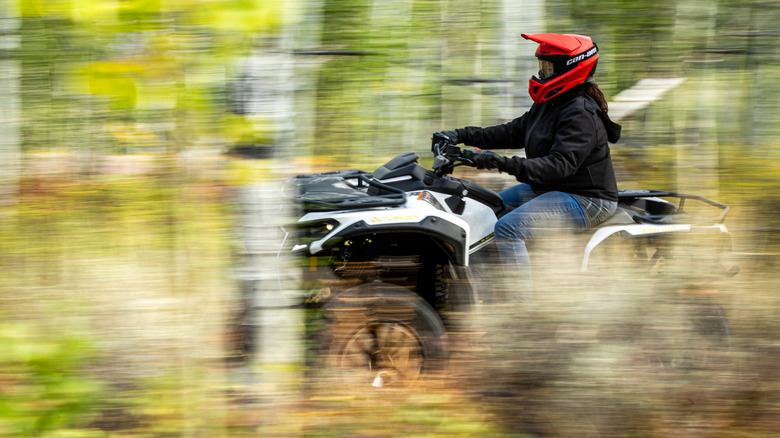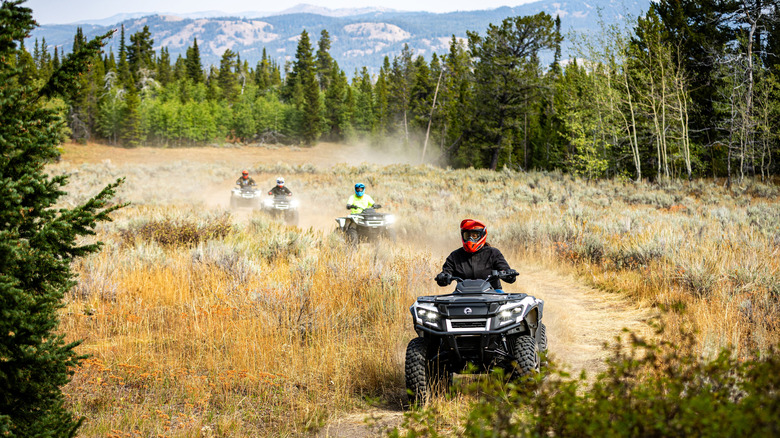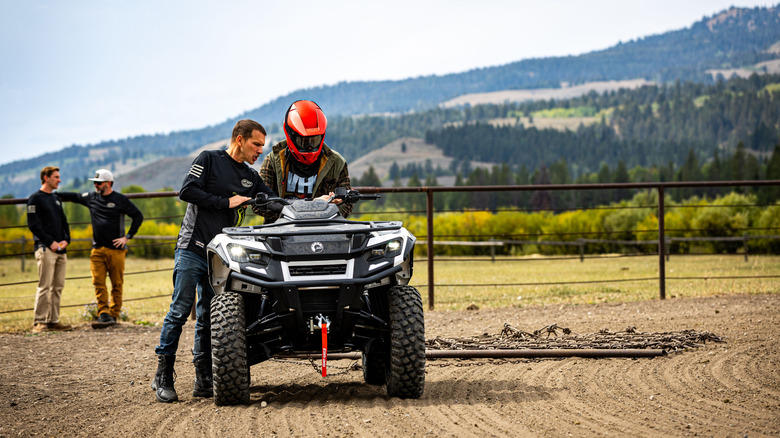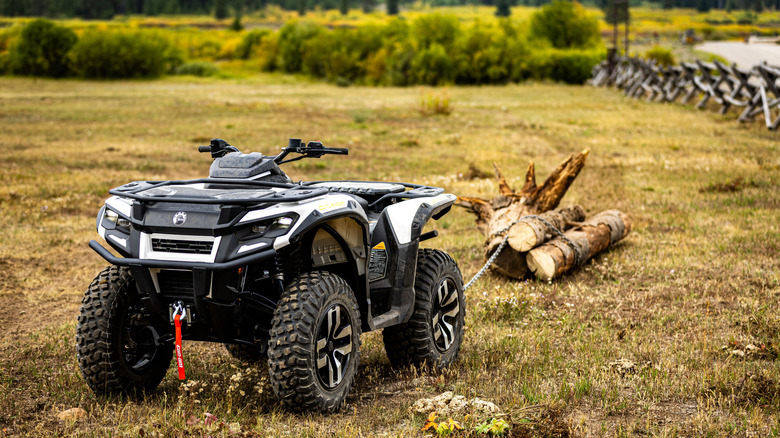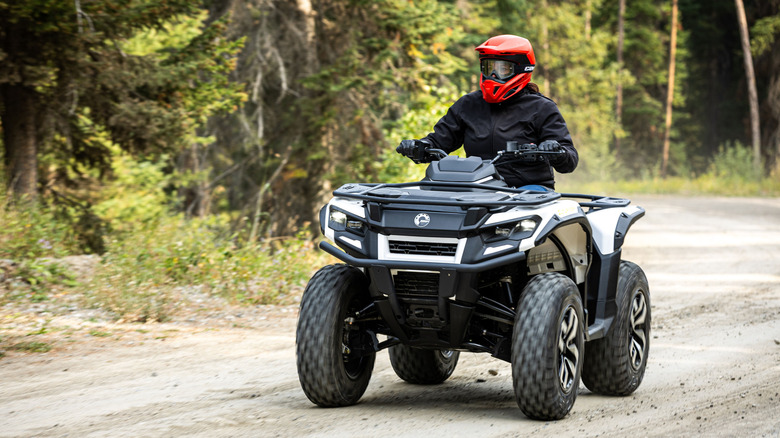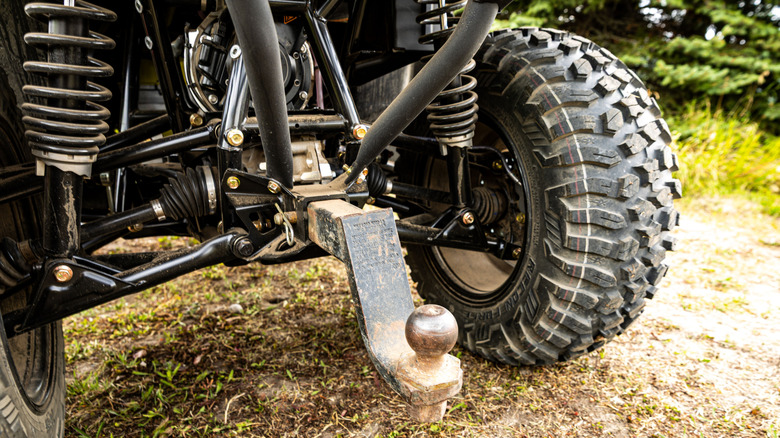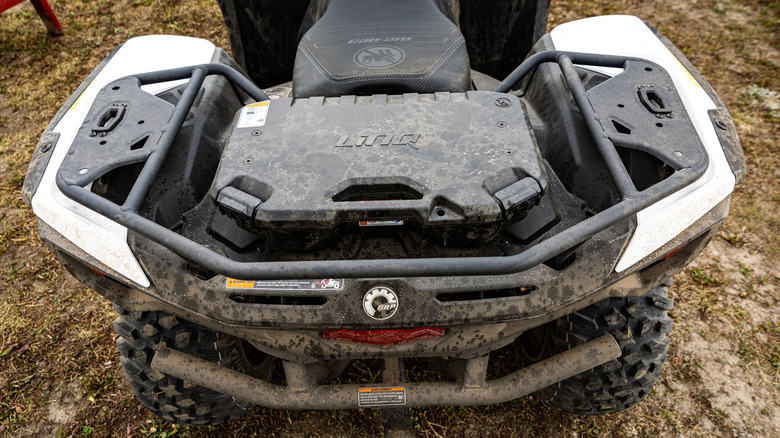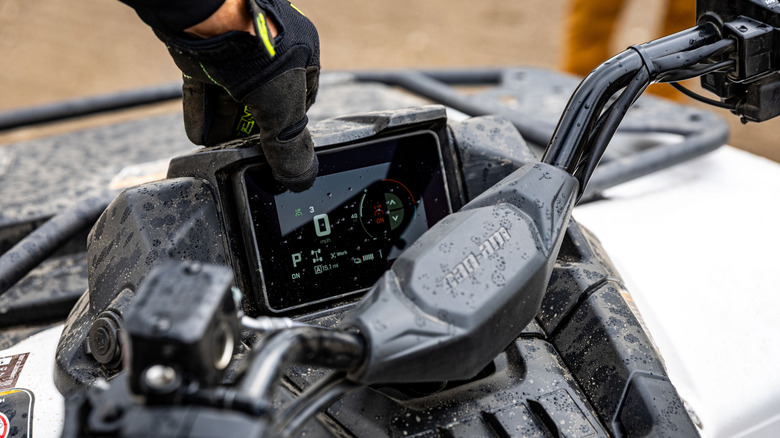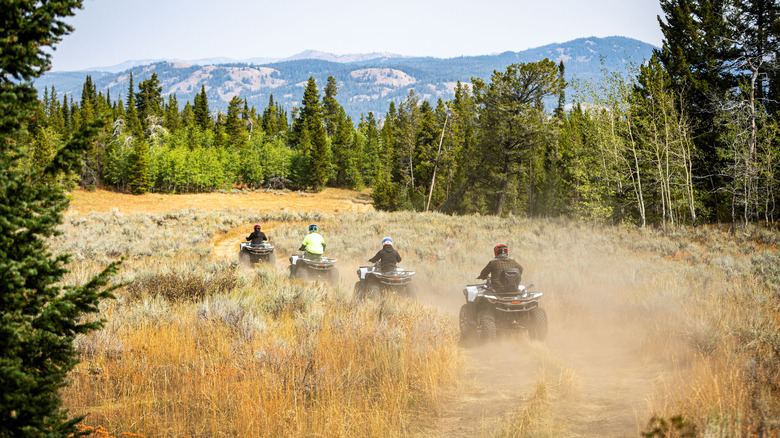Can-Am's 2026 Outlander EV Is A Risky Bet, With A Clear Payoff For The Right Rider
I wasn't prepared for how much everyone in Wyoming obsesses over bears. In fact, when I saw the Bear Spray Rental counter in the Jackson Hole airport, I assumed it was a joke, a photo op for dumb tourists like me. Then I started to seriously wonder, will this new Can-Am I'm riding be able to outrun a bear?
I was there because yet again, Can-Am comes out with a vehicle — a machine, actually — that doesn't seem to make much sense at first, but actually has glints of brilliance. Can-Am has already successfully convinced me there are customers out there for electric versions of its models. Next on the list? An all-new electric ATV, the first of its kind.
The 2026 Can-Am Outlander carries its name over from the gas-powered Outlander, which was introduced in 2004. There are a couple of inherent contradictions. First, while most of Can-Am's vehicles are recreational in nature, the new Outlander is designed primarily for work: farm chores, commercial site maintenance, and the like. Second, though Can-Am acknowledges the brand's Canadian customer base tends to be more willing to buy an EV, the company expects to sell more of the new Outlander in the United States. It proved its mettle during a day at the remote Wyoming ranch, but it may be an uphill battle to convince American farmers that it might be time to replace their crusty old gas and diesel tractors with a plug-in quad.
Sage advice
Because I did not see any bears in Wyoming, the Outlander EV was more than fast enough for my tastes. At no point did I wish for more speed; at several points (after careening off the trail and into the sagebrush) I wished for the rest of our group to perhaps go a little slower. First of all, keep in mind that the Outlander EV should not be ridden on pavement; it says so right on the large instruction/warning placard on the front driver's side fender, in front of the driver's left foot. That leaves various combinations of dirt, grass, or gravel as potential surfaces for Outlander EV travel.
If you're riding in a group, the vehicle in front of you will kick clouds of dust and rocks into your face, and the fact that this Outlander is an EV will not spare you. By the time you slow down enough to see through the dust clouds and pick the gravel out of your collar, you'll have fallen far behind the pack and might possibly be embedded in a sagebrush-filled ditch, at which point you may be more worried about rattlesnakes than bears. To the Outlander EV's credit, I tested the reverse feature in several ditches, and there was plenty of torque to help grip the various surfaces, turn on a tight radius, and keep going with pride mostly intact. Also, sun-warmed sage smells absolutely wonderful when it's freshly crushed by an ATV.
Discreet as a farmer's daughter
So yes, the Outlander EV is perfectly competent. It plunged up short but steep hills that I did not particularly want to attempt, and it did so just fine. But! Unlike most other Can-Am vehicles I've tested for SlashGear, the Outlander EV isn't designed for trail riding or motorsports, and as such, it's unlikely the target customer will be riding in a group. It is designed as an efficient, versatile replacement for a farm implement, such as a tractor, or some other type of commercial non-street-legal vehicle, such as a gas-powered ATV or side-by-side. This reminder is so important that it's right there in front of the driver's foot, in case one should lose sight of the fact that they're ostensibly at a ranch to work, rather than play. We were testing the Outlander EV's suitability to get around a large, rural area, and for that, it is perhaps more fun than it should be.
The Cam-Am Outlander EV is super quiet, so it's ideal for hunters. The ergonomics, for the most part, are great. A person of average height and agility should have no problem climbing on, getting settled, reaching the pedals and handlebars, and seeing the landscape up ahead. The footbeds are huge and grippy, so it's easy to maneuver between sitting and standing. I've been on Can-Am vehicles that were more comfortable, for sure, but those were for pleasure rather than work, with significantly higher price tags. My only real gripe with the ergonomics is that I slid around on the seat quite a bit, which is easily fixed by swapping out the seat lid, adding a padded seat cover, or wearing more appropriate pants.
All work, no play
On the surface, there are only subtle clues that differentiate the work-oriented Outlander Electric from play-oriented ATVs. Exterior adornments are minimal; there are no turn signals, horn, or side mirrors. Also, while most Can-Am vehicles have a touchscreen display, the Outlander Electric's simpler system uses handlebar-mounted controls.
According to Can-Am, in North America, a work vehicle cannot be sold with horns or turn signals, because these features "signal user intent" — in other words, you don't need to communicate with other riders unless you're traveling with other riders, and if you're using the Outlander Electric as intended and as approved for use, then there won't be any other riders in need of communication.
Can-Am notes, however, that side mirrors are mandated in the United States for trail use, and there is a mirror mount on the handlebar, so it's possible to add one. After a while on the farm, I can see how the urge to check the mirror would dissipate over time, though I'd personally still want one anyway. Bear safety and all that, as well as for more likely tasks such as checking to ensure your tow load is okay and is still being trailed behind you. The Outlander Electric has the same 1,830-pound towing capacity as the gas Outlander.
In Work mode, accessible through the infotainment display, the Outlander Electric adjusts the throttle for more precise control, more torque, and less wheel spin, ideal for towing and hauling. There's also a crawl setting that ensures a consistent speed as low as 3 mph, intended for even and steady movement during chores like planting or fertilizing.
Powertrain and charging
In terms of performance, Can-Am keeps it simple. The Outlander Electric features the same Rotax powertrain as the Pulse and Origin motorcycles we tested a year ago, making 47 horsepower and 53 pound-feet of torque. The powertrain, including the motor, battery, inverter, and on-board charger is liquid-cooled, and the direct-drive system contributes to less maintenance and a completely silent ride. The tires, too, are designed for a combination of stealth and efficiency, while maintaining good traction on surfaces other than pavement.
This Can-Am ATV uses the J1772 charging standard, so it's compatible with many at-home or commercial Level 2 chargers. Since it can't be driven on-road, accessing public chargers isn't really a concern, though it's plausible some of these will end up using public chargers while on duty at college campuses, resort properties, and similar environments. The charging cable is the same used by the Pulse and Origin motorcycles. With a Level 2 charger, it takes about 50 minutes to charge from 20% to 80%, and with a standard wall outlet, it takes about five hours.
Other specs and features
The simple 5-inch color display is new for the Outlander lineup, and the front console features a phone holder, a USB-A port, and a USB-C port. The USB ports are for charging only; unlike some Can-Am vehicles we've reviewed, there's no smartphone integration here. My phone didn't have reception the entire time we were at the ranch, anyway.
The Outlander Electric has high and low gears, as well as the aforementioned Work mode, a Sport mode, and selectable two- or four-wheel drive with an automatically locking differential. Underneath, you'll find a full skid plate and a 2-inch hitch receiver.
Amid all this cool stuff, there's one minor gripe. The Outlander EV has a reverse-on-the-fly feature, and reverse is always nice. However, I prefer the Can-Am Spyder's reverse feature, which has a couple more steps but worked more consistently in the times I've tested it. In this case, there seemed to be a lag between selecting reverse and the gear changing on the display, which resulted in some back-and-forth, not sure if it had actually worked.
Linq accessories are welcome here
The Can-Am Outlander Electric features the brand's Linq accessories system. The vehicle itself has various mounting points, and there are more than 100 compatible accessories for the Outlander in the Can-Am catalog. In this case, Outlander-specific accessories largely carry over from the previous gas version, since the vehicles themselves are nearly identical. Examples include a removable passenger seat on the two-rider model, a gun rack, and numerous types of locking storage, such as front-, top-, and side-case options. The accessories team kept mentioning that the rubber straps are perfect for holding a chainsaw, though they did not provide chainsaws to demonstrate. They can also hold bear spray, I've been assured.
Can-Am says that customers have expressed concern about depleting range with certain accessories, though that shouldn't deter buyers from options like audio systems and supplemental lighting, because such features don't use a lot of energy. There are more extreme accessories, as well, such as tracks for snow travel, which will decrease range by about 25%.
Range and market
I've had nothing but good-to-great experiences with Can-Am. Canadians are friendly and honest, and who doesn't love a good Quebecois accent? Yet, despite my college years spent trekking up to Montreal for concerts, I was still skeptical of Can-Am's claim, and I'm paraphrasing heavily here, that Canadians are more willing to embrace an electric ATV, even though it won't keep them warm at night, while Americans are generally totally resistant to the idea of an electric ATV because Americans love gas and fossil fuels in general. Yet Can-Am anticipates about 65% of Can-Am Outlander Electric sales will be in the U.S., with Canada making up the remaining 35%.
According to Can-Am, the company's data implies that a big part of American consumers' hesitation toward EV adoption is that Americans are wary of paying a substantial premium for an EV. Furthermore, range is forever a concern. To that end, Can-Am is cautious about describing range for a vehicle for which there are no standards. In optimal conditions, Can-Am says, the Outlander EV can go 50 miles on a full charge, theoretically. However, there's no EPA testing regimen here, nothing to hold manufacturers to a standard.
Therefore, Can-Am says, the company developed "average utility range conditions" that account for a range of conditions, including terrain, workload (such as towing), and weather. After about 31,000 miles of extreme testing, including running through some of Canada's toughest winter conditions and towing logs through mud and snow, Can-Am advertises a range of about 31 miles for this electric ATV. Can-Am also says this ATV is good in all seasons (-4 to 104 Fahrenheit) thanks to its liquid cooling system and integrated battery heater.
2026 Can-Am Outlander Electric verdict
The 2026 Can-Am Outlander Electric is available now, and is available at Can-Am dealers throughout North America. The Outlander Electric starts at $12,999 for the single-seat model and the Outlander Electric Max with a removable passenger seat starts at $14,999. These prices do not include destination fees.
Despite an EV being, basically, a leap of faith for this ATV's target market, Can-Am notes that the Outlander EV costs only about a 20% premium over a comparable gas-powered Can-Am ATV; namely, the gas Outlander. There are no direct comparisons to other brands here, but Can-Am points out that Polaris is the only major competitor in this segment that offers both gas-powered and electric versions of the same vehicle, and in that case, the EV version costs about 50% more. The applicable Polaris vehicles for this comparison are side-by-sides, not ATVs, but the in-brand pricing is still worth noting, for skeptics who are wary of EV markups. In any case, for the time being, the Can-Am Outlander EV stands alone in the kinda-niche-farm-ranch-off-road-but-not-adventure segment.
